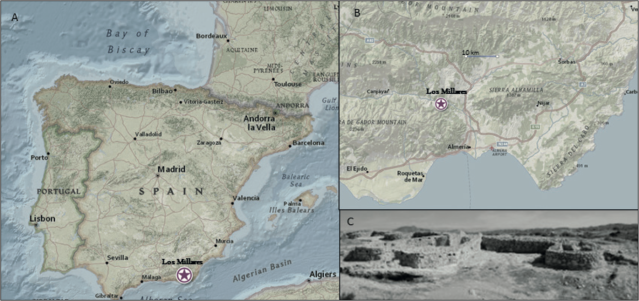Last week I put up a post about my paper on the bioarchaeology of Marroquíes, which had recently been published in MENGA: Journal of Andalusian Prehistory. I’m also co-author on a second paper in the volume, titled Stable Isotope Analysis of Human Remains from Los Millares Cemetery (Almería, Spain, C. 3200-2200 Cal BC): Regional Comparisons and Dietary Variability, written with friends and colleagues Anna Waterman, Jonathan Thomas, and Rob Tykot.
 I’ve known Anna and John since 2010, when I first worked at Bolores, a site excavated by Katina Lillios and a team from the University of Iowa in Torres Vedras, Portugal. Bolores is a Late Neolithic – Copper Age mortuary rock shelter, and is responsible for first sparking my interest in Iberian Late Prehistory. I returned to Bolores for the final field season in 2012, and Anna, John and I have talked about publishing something together ever since.
I’ve known Anna and John since 2010, when I first worked at Bolores, a site excavated by Katina Lillios and a team from the University of Iowa in Torres Vedras, Portugal. Bolores is a Late Neolithic – Copper Age mortuary rock shelter, and is responsible for first sparking my interest in Iberian Late Prehistory. I returned to Bolores for the final field season in 2012, and Anna, John and I have talked about publishing something together ever since.

In this high-octane photograph from summer 2012, Anna is wearing a red jumper and looking thoughtful, while I am morosely clutching at my feet for some reason. Photo Credit: Joe Artz.
The publication of this new research is particularly exciting as it represents the first dietary isotopic analysis of the people buried at Los Millares*, arguably the most famous site in Copper Age Iberia due to its size, multiple walls, barbican entrance, thirteen hill forts, and extensive cemetery. There hasn’t been a full bioarchaeological analyses conducted for Los Millares, so the stable isotope analyses published here provides an initial glimpse of what life was like for the inhabitants of this village. The isotopes analyzed include δ13Cco, δ13Cap, δ15N, and δ18O (carbon and nitrogen from collagen, and carbon and oxygen from apatite).
Despite the location of Los Millares only 20km away from the Mediterranean Sea, our results suggest that people were largely reliant on terrestrial resources, with limited input of marine foods in their diets. This patterning matches that found at other sites from Late Prehistoric Iberia, potentially reflecting a broadly distributed subsistence strategy that focused heavily on mixed agricultural production, with minor incorporation of wild or aquatic resources. The standard deviations for δ13C and δ15N (at 0.4‰ and 0.6‰ respectively) are larger than those anticipated for homogeneous diets. meaning that plant and protein intake thus likely varied between individuals, with δ13Cap values revealing diversity in carbohydrate resources. The human sample available for analysis was small (n=12),so in the future we hope to analyze wild and domestic faunal remains from Los Millares in order to expand these results and clarify dietary practices in Late Prehistoric Almería.

If you’re interested in reading the full paper it’s up on academia.edu, here:
*Note that this link refers to it as a city, but it is more appropriately categorized as a large village.



Pingback: Bone Broke Year in Review 2018 | Bone Broke